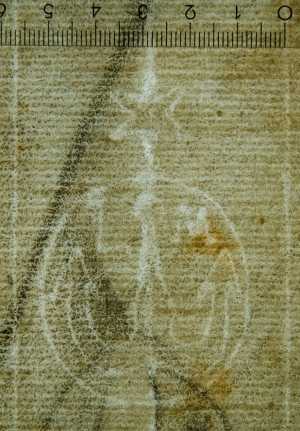Specifications
| Title | Study of Standing Bearded Man and Three Young Men |
|---|---|
| Material and technique | Black chalk |
| Object type |
Drawing
> Two-dimensional object
> Art object
|
| Location | This object is in storage |
| Dimensions |
Height 413 mm Width 262 mm |
|---|---|
| Artists |
Artist:
Anoniem
Previously attributed: Ottavio Vannini Previously attributed to: Andrea del Sarto (Andrea d’Agnolo) Previously attributed: Giovanni Battista Naldini |
| Accession number | I 373 (PK) |
| Credits | Loan Stichting Museum Boijmans Van Beuningen (former Koenigs collection), 1940 |
| Department | Drawings & Prints |
| Acquisition date | 1940 |
| Creation date | in circa 1600 |
| Watermark | Anchor in a circle surmounted by a six-pointed star, inscribed initials L and M (70 x 44 mm, upside-down, left of center, on P3 van 9P, vH, cropped folio), no similar type with inscribed initials among Briquet 477-529 (mostly Veneto c. 1500-1600), neither in Piccard Online, but very similar (even nearly identical) to the watermark (with inscribed initials L and M) in a drawing attributed to Pier Dandini (Florence 1646-1712) in the Louvre, inv. 16 128, formerly as anonymous Italian 17th c.; Ariane de la Chapelle in Monbeig-Goguel 2005, no. 278, pp. 510-511, fig. 4 [AE 1 June 2021] |
| Inscriptions | ‘25’ (lower right, pencil) |
| Collector | Collector / Franz Koenigs |
| Mark | F.W. Koenigs (L.1023a) |
| Provenance | art dealer Julius W. Böhler (1883-1966), Lucerne; Franz W. Koenigs (1881-1941, L.1023a), Haarlem, acquired in 1929 (Andrea del Sarto); D.G. van Beuningen (1877-1955), Rotterdam, acquired with the Koenigs Collection in 1940 and donated to Stichting Museum Boijmans Van Beuningen |
| Research |
Show research Italian Drawings 1400-1600 |
| Literature | Berenson 1938, no. 1761A; Berenson 1961, no. 1761 A-3 (Naldini); Freedberg 1963, p. 15 and 260 (Naldini) |
| Material | |
| Object | |
| Geographical origin | Italy > Southern Europe > Europe |
Do you have corrections or additional information about this work? Please, send us a message
























